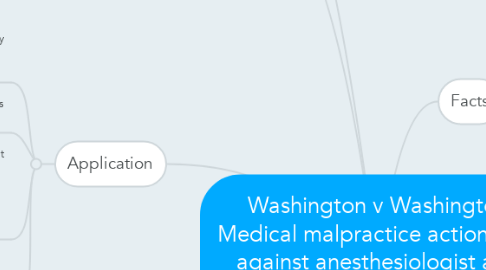Washington v Washington Medical malpractice action filed against anesthesiologist and nurse-anesthetist after patient suffered brain injury from oxygen deprivation.
by Nicole Cooper


1. Ruling:
1.1. Superior Court entered judgement on verdict for plaintiff against the hospital
1.1.1. Individual defendants settled midway through trial.
1.2. hospital appealed
1.2.1. hospital disagreed with expert testimony on standard of care
2. Application
2.1. Court examined these facts: that the standard of care is the course of action that a reasonably prudent professional would have taken under the same or similar circumstance.
2.2. The court rejected the "locality" rule in regards to this case.
2.3. Relevant fact given to the rule of law is that during jury questioning "voire dire", the plaintiffs expert, Dr. Steen had reviewed WHC's President's Report for 1986-87 and believed that the report indicated the hospital was indeed a teaching hospital.
2.4. The court interpreted the rule that if WHIC was a teaching hospital then, it would have the carbon dioxide monitors' as, the other teaching hospitals had them.
3. Conclusion
3.1. The conclusion would be that since four other teaching hospital institutions had the carbon dioxide monitors, that would be the standard of care. WHC did not have the monitors. In negligence, the duty would be to have the monitors as standard of care. The breach was that the hospital did not have the monitors, this caused the brain injury, the damages being what the doctor, nurse anesthetist and hospital paid to plaintiff.
4. Influence
4.1. There was a case decided in 1998 that used The principal for entitlement to hold a hospital liable from case # 579 A.2d 177 in that contribution is that the parties be joint tortfeasors in the sense that their negligence concurred in causing the harm to the injured party. Washington v. Washington Hosp. Ctr., 579 A.2d 177.....The issue raised by this appeal is whether a settling defendant in an automobile negligence case has a right to equitable contribution or indemnity from a non-party hospital which allegedly aggravated plaintiff's initial injuries. http://caselaw.findlaw.com/dc-court-of-appeals/1309229.html
5. Issue
5.1. The issue is "whether a reasonable prudent tertiary care hospital at time of injury and according to national standards, would have supplied carbon dioxide monitor to patient undergoing general anesthesia"
5.1.1. Whether by 1986 Standard of Care required carbon dioxide monitors in operating rooms
6. Facts
6.1. November 7, 1987 LaVere Aice Thompson had elective surgery
6.2. The Procedure required general anesthesia
6.3. 10:45 the nurse anesthetist (under the supervision of the doctor inserted the endotracheal tube into the patient for oxygen
6.3.1. Nurse Anesthetist settled
6.4. The doctor determined the tube was properly inserted
6.4.1. The doctor settled
